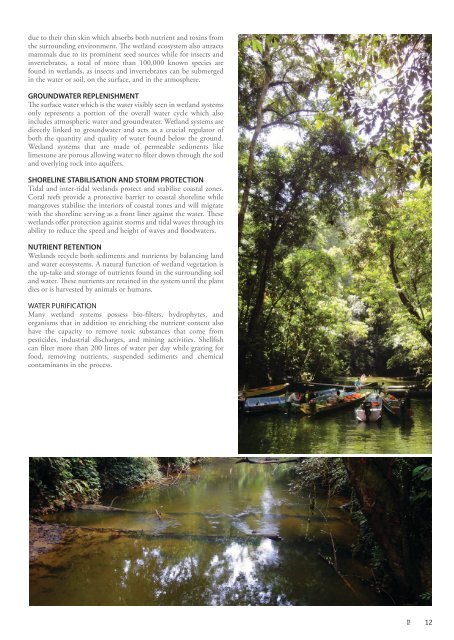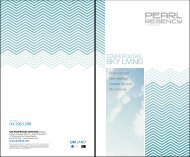Create successful ePaper yourself
Turn your PDF publications into a flip-book with our unique Google optimized e-Paper software.
due to their thin skin which absorbs both nutrient and toxins from<br />
the surrounding environment. The wetland ecosystem also attracts<br />
mammals due to its prominent seed sources while for insects and<br />
invertebrates, a total of more than 100,000 known species are<br />
found in wetlands, as insects and invertebrates can be submerged<br />
in the water or soil, on the surface, and in the atmosp<strong>here</strong>.<br />
GROUNDWATER REPLENISHMENT<br />
The surface water which is the water visibly seen in wetland systems<br />
only represents a portion of the overall water cycle which also<br />
includes atmospheric water and groundwater. Wetland systems are<br />
directly linked to groundwater and acts as a crucial regulator of<br />
both the quantity and quality of water found below the ground.<br />
Wetland systems that are made of permeable sediments like<br />
limestone are porous allowing water to filter down through the soil<br />
and overlying rock into aquifers.<br />
SHORELINE STABILISATION AND STORM PROTECTION<br />
Tidal and inter-tidal wetlands protect and stabilise coastal zones.<br />
Coral reefs provide a protective barrier to coastal shoreline while<br />
mangroves stabilise the interiors of coastal zones and will migrate<br />
with the shoreline serving as a front liner against the water. These<br />
wetlands offer protection against storms and tidal waves through its<br />
ability to reduce the speed and height of waves and floodwaters.<br />
NUTRIENT RETENTION<br />
Wetlands recycle both sediments and nutrients by balancing land<br />
and water ecosystems. A natural function of wetland vegetation is<br />
the up-take and storage of nutrients found in the surrounding soil<br />
and water. These nutrients are retained in the system until the plant<br />
dies or is harvested by animals or humans.<br />
WATER PURIFICATION<br />
Many wetland systems possess bio-filters, hydrophytes, and<br />
organisms that in addition to enriching the nutrient content also<br />
have the capacity to remove toxic substances that come from<br />
pesticides, industrial discharges, and mining activities. Shellfish<br />
can filter more than 200 litres of water per day while grazing for<br />
food, removing nutrients, suspended sediments and chemical<br />
contaminants in the process.<br />
I!<br />
12














